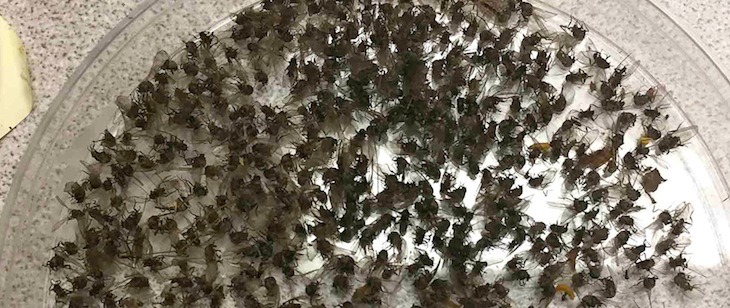Black flies killing livestock and wild animals in the Arkansas Delta
by April 12, 2018 7:11 pm 2,798 views

If you see a deer hiding in a shop, shed or other dwelling in the Mississippi Delta Region, it wouldn’t be unusual. Blood-sucking black flies, or buffalo gnats, have killed scores of animals in the southern parts of the region, Kelly Loftin, extension entomologist for the University of Arkansas System Division of Agriculture told Talk Business & Politics.
The flies don’t like to fly in dwellings, and it’s not unusual for deer to try and hide from them during daylight hours, he said.
The number of animals killed has not been tabulated, and Loftin said he didn’t want to speculate on specific numbers until all information has been gathered. Each year, black flies are an issue in the area, but this year has been much worse, Loftin said. Heavy rains and temperatures bouncing between the 40s and 70s in the last few weeks, have caused population spikes.
“We’re seeing a bumper crop of black flies, likely as a result of floods in February and March,” Loftin said, “These are late winter, early spring pests that usually go away when temperatures warm above 80 degrees.”
He added: “I don’t remember a year this bad, ever.”
Grant Beckwith, Arkansas County extension staff chair for the Division of Agriculture, said a cattle producer in DeWitt lost a prize bull and cow to the flies. Deer have been found dead in the wild from fly bites.
“I’ve also heard reports that several horses had died and there were some deer lying dead in fields,” he said. “I had one farmer tell me he was met at his carport by a deer who was inside trying to get away from the gnats. The gnats don’t like to be under a roof or indoors. Buffalo gnats are a fact of life down here,” Beckwith said. “The running joke is that the buffalo gnats will have you looking forward to mosquito season.”
The Arkansas Game and Fish Commission closed the Cook Lake Conservation Education Center earlier this spring because of the fly outbreak. The center posted photos on Facebook page of with piles of dead black flies on the nature center’s doorstep, saying “at this time, it is impossible for visitors to do anything unless covered with mosquito nets.” The nature center has since re-opened as the number of flies have dropped in recent days, Loftin said.
Unlike mosquitoes that breed in stagnant water, black flies can breed in virtually any flowing water.
“In species that breed in large rivers, as many as a billion flies can breed per kilometer of river per day,” Loftin said. “Other species breed in small heavily wooded streams.”
Females deposit eggs, 200 to 800 per female on the water surface, which then sink to the silt. Eggs can also be deposited on inundated flood plains. These eggs can be viable for years and hatch when the next big spring flood occurs. Most black fly larvae are filter feeders, with the larvae feeding on organic matter in the water as it flows by.
“Fortunately, we only see one generation per year,” Loftin said.
Once the flies mature into adulthood, they feed on blood. The flies, which swarm around humans and livestock, cut the skin and suck the blood that pools in the cut. They have a strong anticoagulant that can result in severe reactions in allergic individuals. Most people end up with a welt accompanied by a long-lasting itching.
There are a couple of ways the flies can kill.
“If a massive swarm attacks mammals or poultry, death is usually the result of anaphylactic shock or toxemia caused by a large influx of black fly saliva,” Loftin said. “It’s rare, but it has been observed that livestock can die from being bled dry.”
Black flies are also carriers of a disease in poultry called leucocytozoonosis, a malaria like disease in ducks, geese and turkeys. The flies are daytime feeders and prefer feeding outdoors. In addition to staying inside, there are a few methods to protect people and animals from black flies. For livestock, when populations are extreme, and shelter is unavailable, and whole body permethrin sprays are not possible, producers use heavy smoke to protect the animals, Loftin said.
“Heavy smoke does provide livestock relief from the attack,” he said. “Of course, when they are huddled around the smoke they do not graze.”
Loftin said the producer who lost the cattle has since begun to use smoke and sprayed permethrin on his livestock. During heavy black fly flights, producers can shelter animals in stables or barns during the daytime. Insecticides such as permethrin applied directly to livestock may provide short-term relief from black fly biting. Thorough coverage of the animal’s body is necessary especially during heavy black fly infestations.
When the situation allows, such as small-scale poultry production, fans may provide relief because black flies don’t like windy conditions. Some poultry producers have reported success with products containing Citronella oil.
For human protection, avoiding them during the day and using of repellents when outdoors during the day are the best options. Wearing bright or light colored long-sleeved shirts, pants and fine screened netting over your head will prevent bites.
Loftin said repellents containing DEET have shown mixed results and some data has demonstrated that botanical repellents containing geraniol are effective as well as repellents containing picaridin or IR3535. Clothing-only repellents containing permethrin, such as Permanone or Sawyer clothing repellent, will repel black flies but can only be applied to shirts, pants or hats and not to skin.
